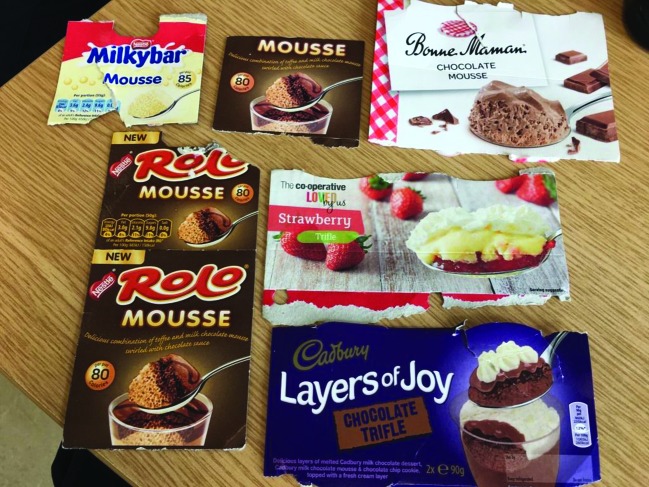An elderly female developed anarthria with prominent emotionality over an 18-month period before specialist neurological assessment. Although tongue electromyography was normal, her corticobulbar signs were consistent with amyotrophic lateral sclerosis (ALS), a pattern that, in the absence of functional impairment outside of speech and swallowing, is appropriately termed progressive bulbar palsy. Such patients, often elderly females, may remain ambulant and independent for many months, sometimes years, despite typically rapid anarthria.1 Electromyography may be insensitive to denervation, even when genioglossus is sampled, and this can contribute to diagnostic delay in patients with corticobulbar presentations of ALS who are frequently referred to ‘TIA’ or ENT clinics.2 When asked about her nutritional state, she revealed a collection of pictures of her favourite foods carried in her handbag to facilitate communication (figure 1).
Figure 1.
Packaging cut-outs carried by the patient to indicate her preferred food in the absence of speech. It was noted that all of them were confectionery items, consistent with observations that patients with amyotrophic lateral sclerosis may develop an exaggerated preference for sweet foods as a manifestation of frontal lobe pathology.
ALS has pathological overlap with frontotemporal dementia through the common feature of cytoplasmic inclusions containing TDP-43. A hexanucleotide expansion in C9orf72 is associated with both ‘pure’ and mixed cases of ALS and frontotemporal dementia which may occur within the same pedigree.3 Overt dementia is not common in ALS (up to 15% in population-based studies), and is typically an early feature coincident with motor signs when it occurs. However, up to 50% of patients with ALS show a spectrum of more subtle cognitive and behavioural change, though most of these will not go on to develop dementia during the course of their disease. There have been criteria developed to reflect this broader phenotypic range of extramotor involvement in ALS.4
An acquired preference for sweet foods, often with a narrowed repertoire, is included in the criteria for frontotemporal dementia. In ALS cases, it is a clue to frontotemporal involvement, and part of an emerging array of metabolic disturbances common to both disorders.5 It should prompt more detailed neuropsychological assessment if there are wider concerns about behaviour or capacity.
Footnotes
Contributors: MRT saw the patient, conceived and drafted the manuscript. KT saw the patient and edited the manuscript.
Competing interests: None declared.
Provenance and peer review: Not commissioned; externally peer reviewed. This paper was reviewed by Jonathan Rohrer, London, UK.
References
- 1. Burrell JR, Vucic S, Kiernan MC. Isolated bulbar phenotype of amyotrophic lateral sclerosis. Amyotroph Lateral Scler 2011;12:283–9. 10.3109/17482968.2011.551940 [DOI] [PubMed] [Google Scholar]
- 2. Turner MR, Scaber J, Goodfellow JA, et al. . The diagnostic pathway and prognosis in bulbar-onset amyotrophic lateral sclerosis. J Neurol Sci 2010;294:81–5. 10.1016/j.jns.2010.03.028 [DOI] [PubMed] [Google Scholar]
- 3. Majounie E, Renton AE, Mok K, et al. . Frequency of the C9orf72 hexanucleotide repeat expansion in patients with amyotrophic lateral sclerosis and frontotemporal dementia: a cross-sectional study. Lancet Neurol 2012;11:323–30. 10.1016/S1474-4422(12)70043-1 [DOI] [PMC free article] [PubMed] [Google Scholar]
- 4. Strong MJ, Abrahams S, Goldstein LH, et al. . Amyotrophic lateral sclerosis – frontotemporal spectrum disorder (ALS-FTSD): Revised diagnostic criteria. Amyotroph Lat Scl Fr 2016. [DOI] [PMC free article] [PubMed] [Google Scholar]
- 5. Ahmed RM, Irish M, Piguet O, et al. . Amyotrophic lateral sclerosis and frontotemporal dementia: distinct and overlapping changes in eating behaviour and metabolism. Lancet Neurol 2016;15:332–42. 10.1016/S1474-4422(15)00380-4 [DOI] [PubMed] [Google Scholar]



